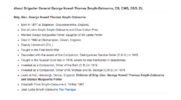I'm hoping to find a picture of the Chap ~
The scope now likely dates to the Boer War as he was there and it would be useful, he is quoted in this article from;
Looks like he got to Pretoria the Hard Way !
Manchester Archive;
in
The Victorian soldier in Africa
Chapter DOI:
https://doi.org/10.7765/9781526137913.00017Online Publication Date: 30 Jul 2018
Open Access (free)
Even before they faced the new realities of warfare, especially fire-zones swept by smokeless fire from magazine rifles, British soldiers had to adapt to the rigours of campaigning in South African conditions. Apart from the small garrisons in Cape Colony and Natal, and the seasoned soldiers sent from India and the Mediterranean garrisons, many short-service soldiers and reservists from Britain were new to the demands of colonial service. They appreciated the welcome from the English-speaking community, particularly in Natal where ‘the people’, claimed Lieutenant George Smyth Osbourne (2/Devons), ‘are very loyal, much more so than at Cape Colony’,
3 and, in Durban, added Private L. Graham (2/Somerset Light Infantry), they gave ‘us fruit, fags, tobacco, and made a great fuss of us’.
4 Yet soldiers had to acclimatise, and they struggled when required to march, often on short rations of bully beef and biscuit, in the heat (and flies) of the day before enduring cold nights and periodically heavy fogs or severe storms.
5 Corporal Devas (2/Somersets), posted with his heliograph on top of Mount Umkolomba, Natal, described how he had never ‘been in such a funk before; a thunderstorm is no joke on top of these mountains’.
6
The 1/Devons and five companies of 2/Gordons (formerly the 92nd Highlanders who fought at Majuba) were soon in action at Elandslaagte (21 October 1899), serving with half a battalion of the Manchesters and the Imperial Light Horse. Many of the Devons had recently fought on the North-West Frontier, and so appreciated the extended formation adopted by another Tirah veteran, Colonel Ian Hamilton. ‘We were advancing in single rank’, wrote Private J. Isaac (Devons), ‘about 15 paces interval from one another, so we could not form a big target for them.’
7 While the Devons with close artillery support launched a frontal attack across the veld, some 2 miles distant the Gordons and Manchesters advanced, again with artillery support, in ‘open column’ with intervals of ‘about 100 yards’ between companies round the horseshoe ridge towards the enemy’s left flank. Private S. Anstey (Devons) described how bullets rained ‘down on us like large hailstones’, but when they ‘were within 200 yards of their position . . . the order to charge was given, and every man rushed as for revenge into the enemy, who did not face the bayonet’.
8 Devons and Gordons then recalled bitterly how the Boers waved the white flag, prompting a British cease-fire, before launching another charge ‘with an awful fire, killing a lot of our chaps’.
9 Having rallied his men to repulse these ‘treacherous marksmen’, Captain (then Lieutenant) Matthew F. M. Meiklejohn (Gordons), who lost an arm in the action and earned the VC, observed that two squadrons of cavalry (5th Dragoon Guards and 5th Lancers) completed the rout.
10





